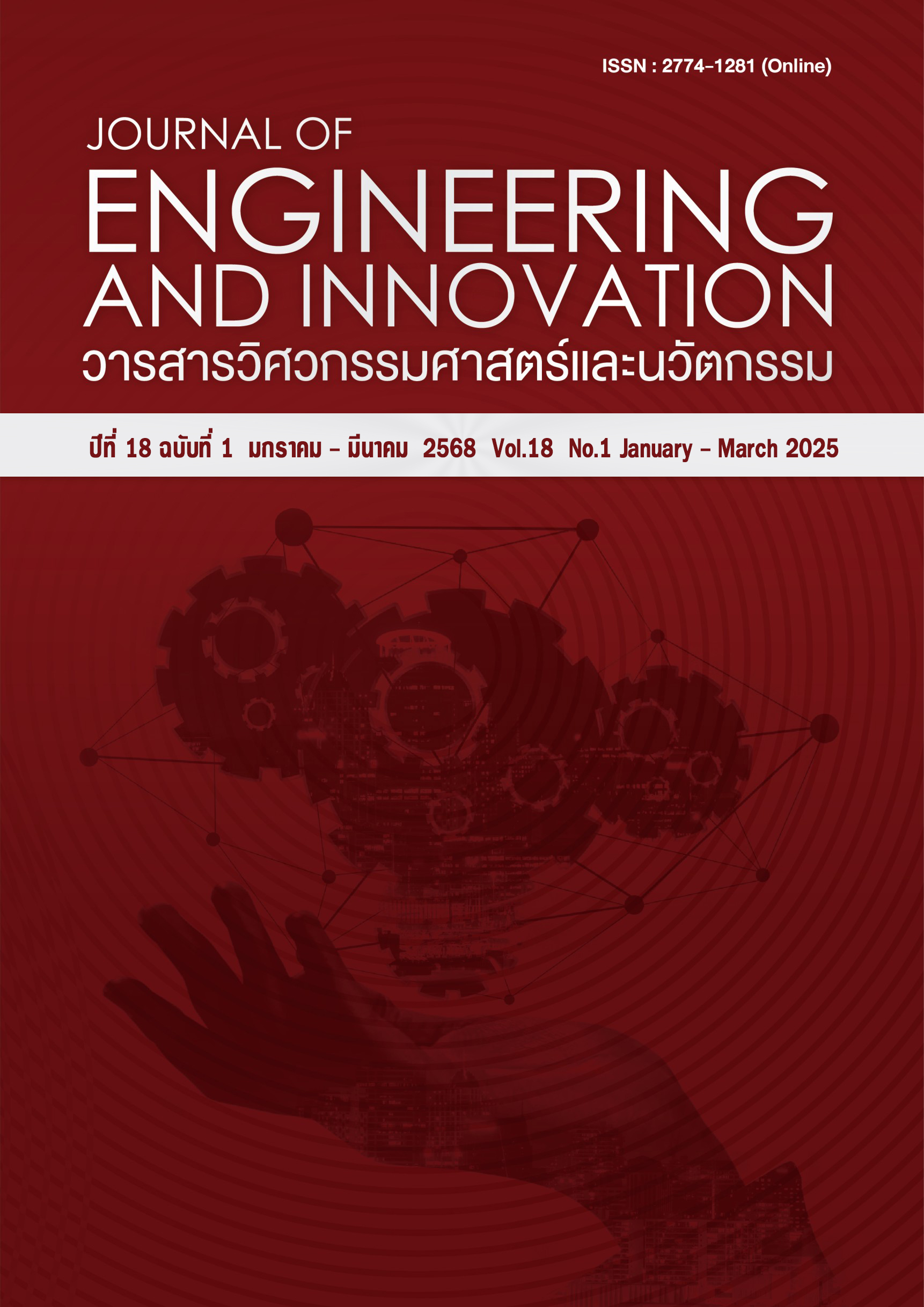A performance and preferences based multi-objective assignment model with fuzzy inference system for worker assignment: a case study of spare parts department of agricultural machinery dealer
Main Article Content
Abstract
The main objective of this paper is to introduce a new multi-objective assignment model based on worker performance and preference analyses. A Fuzzy Inference System (FIS) was applied to analyze workers' performance and preferences with ten criteria. The proposed model was used to solve the worker assignment problem of the case study and compared to the other three assignment methods: the solution from the case study, the linear assignment model based on processing time, and the linear assignment model based on opportunity and self-development. The comparative results showed that the proposed model provided the best solution in terms of overall performance at 0.7169, whereas the other three methods were at 0.4526, 0.6335, and 0.4751, respectively.
Article Details
References
Rardin RL. Optimization in Operations Research. Hoboken, NJ: Pearson Higher Education; 2017.
Nahavandi S. Industry 5.0—A Human-Centric Solution. Sustainability. 2019;11.
Hillier F, Lieberman G. Introduction To Operations Research. McGraw Hill; 2015
Faudzi S, Abdul Rahman S, Rahman RA. An assignment problem and its application in education domain: a review and potential path. Advances in Operations Research. 2018; 1-19.
Grabler I, Roesmann D, Cappello C, Steffen E. Skill-based worker assignment in a manual assembly line. Procedia CIRP. 2021;100: 433-438.
Ritt M, Costa AM, Miralles C. The assembly line worker assignment and balancing problem with stochastic worker availability. International Journal of Production Research. 2016;54(3).
Jeunet J, Orm MB. Optimizing temporary work and overtime in the time cost quality trade-off problem. European Journal of Operational Research. 2020;284(2): 743-761.
Heimerl C, Kolisch R. Scheduling and staffing multiple projects with a multi-skilled workforce. OR Spectrum. 2010;32(2): 343-368.
Nunkaew W, Kimaporn M. Lexicographic goal programming model for solving multi-objective worker assignment problems with grey relational analysis. The Annual Conference on Engineering and Information Technology. 12-14 July, Japan; 2023. p. 205-218.
Zhao Y, Liu J, Li Y, Zhang D, Jensen CS, Zheng K. Preference-aware group task assignment in spatial crowdsourcing: effectiveness and efficiency. IEEE Transactions on Knowledge and Data Engineering. 2023;35(10). 10722-10734.
Sharma J. Operations research theory and application. Delhi: Laxmi Publications; 2016.
Mutlu Ö, Polat O, Supciller AA. An iterative genetic algorithm for the assembly line worker assignment and balancing problem of type-II. Computers & Operations Research. 2013;40(1).
Jiang H, Gomes P, Meer DV. Promoting continuity of care in nurse-patient assignment: a multiple objective heuristic algorithm. Decision Support Systems. 2023;167.
Karas A, Ozcelik F. Assembly line worker assignment and rebalancing problem: a mathematical model and an artificial bee colony algorithm. Computers & Industrial Engineering. 2021;156(4).
Kose Y, Cevikcan E, Ertemel S, Murat M. Game theory-oriented approach for disassembly line worker assignment and balancing problem with multi-manned workstations. Computers & Industrial Engineering. 2023;181(3).
Li Y, Chen X, An Y, Zhao Z, Cao H, Jiang J. Integrating machine layout, transporter allocation and worker assignment into job-shop scheduling solved by an improved non-dominated sorting genetic algorithm. Computers & Industrial Engineering. 2023;179(4).
Suer GA. Optimal operator assignment and cell loading in labor-intensive manufacturing cells. Computers & Industrial Engineering. 1996;31(1).
Nakade K, Ohno K. An optimal worker allocation problem for a U-shaped production line. International Journal of Production Economics. 1999;60: 353-358.
Nembhard DA. Heuristic approach for assigning workers to tasks based on individual learning rates. International Journal of Production Research. 2001;39(9): 1955-1968.
Norman BA, Tharmmaphornphilas W, Needy KL, Bidanda B, Warner RC. Worker assignment in cellular manufacturing considering technical and human skills. International Journal of Production Research. 2002;40(6): 1479-1492.
Aryanezhad MB, Deljoo V, Mirzapour Al-e-Hashem S. Dynamic cell formation and the worker assignment problem: a new model. The International Journal of Advanced Manufacturing Technology. 2009;41: 329-342.
Zaman T, Paul SK, Azeem A. Sustainable operator assignment in an assembly line using genetic algorithm. International Journal of Production Research. 2012;50(18): 5077-5084.
Borba L, Ritt M. A heuristic and a branch-and-bound algorithm for the assembly line worker assignment and balancing problem. Computers & Operations Research. 2014;45: 87-96.
Sadeghi A, Sinaki RY, Suer GA. Bi-objective fuzzy mathematical models in a labor-intensive cell. Procedia Manufacturing. 2018;17: 222-229.
Pereira J, Pimentel C, Santos V. An algorithm for the assignment and scheduling of tasks in human-robot collaboration. Flexible Automation and Intelligent Manufacturing. 18-22 June, Portugal; 2023. p. 208-215
Lu J, Qu Z, Liu A, Zhang S, Xiong NN. MLM-WR: a swarm-intelligence-based cloud-edge-terminal collaboration data collection scheme in the era of Aiot. IEEE Internet of Things Journal. 2024;11(1): 243-255.
Kimaporn M, Nunkaew W. A fuzzy inference system-based hybrid assignment method for cobot assignment problem. Robotics, Automation, and Artificial Intelligence. 14-16 December, Singapore: IEEE; 2023. p. 292-296.
Hooda DS, Raich V, St C. Fuzzy Logic Models and Fuzzy Control: an Introduction. Oxford, U.K.: Alpha Science International; 2022.
Mamdani EH, Assilian S. An experiment in linguistic synthesis with a fuzzy logic controller. International Journal of Man-Machine Studies. 1975;7(1): 1-13.
Oliff H, Liu Y, Kumar M, Williams M. Integrating Intelligence and Knowledge of Human Factors to Facilitate Collaboration in Manufacturing. International Design Engineering Technical Conferences and Computers and Information in Engineering Conference; 2018;18.
Niakan F, Baboli A, Moyaux T, Botta-Genoulaz V. A bi-objective model in sustainable dynamic cell formation problem with skill-based worker assignment. Journal of Manufacturing Systems. 2016;38: 46-62.
Inegbedion H, Inegbedion E, Peter A, Harry L. Perception of workload balance and employee job satisfaction in work organisations. Heliyon. 2020;6(1).
Voordt Tvd, Jensen PA. The impact of healthy workplaces on employee satisfaction, productivity and costs. Journal of Corporate Real Estate. 2023;25(1): 29-49.
Varma C. Importance Of Employee Motivation & Job Satisfaction For Organizational Performance. 2017;6, 10-20.
